How to fix 6 of the most common paddling pains

Avoid the pains of paddling to be more comfortable in the boat so you can paddle more for longer.
Unless you're surfing swell straight into a reef or sending the line down the rapids in a river race, paddle sports are relatively safe and low impact for your body. There is little chance of breaking bones or causing stress fractures by increasing your intensity or distances paddled. With a common-sense approach to increasing intensity or distance per session will more likely better your fitness than break you.
Whether you are competing in sprint, ocean ski, spec ski surf or marathon paddle races there is a standard of miles required that can produce a list of aches and pains from overuse. Unless diagnosed and managed these can lead to something more serious or in the very worst case, prevent you from paddling.
The best approach to any of these lasting aches is to stop what you’re doing and seek help. But to help you keep paddling and enjoying your paddling, we have identified some of the common pains and what you can try to reduce or remove them from your paddling life.
With the exception of sun burns (just slip-on clothes to cover your skin, slop-on sunscreen, and slap-on a hat) many of our paddling problems stem from biomechanical issues (not moving correctly) or incorrect kayak set-up. Understanding the root cause of the problem is ideal, as massage, padding seats etc and changing gear may only address short term issue. The identification of the root causes means that it can be prevented in the first place keeping you healthy and paddling fast.
Consultation with experienced paddlers in your club or sports medical professionals will be the best if the problem persists.
If we've missed any, let us know in the comments below!
Numb legs
Likely causes:
From our recent survey on Paddler Seat Comfort (analysis to be published soon) this is a real issue for many paddlers. The common cause of this being the paddler position in the boat causing tension, stress or compression on the sciatic nerve which runs from the low back to your feet.
That numb feet/leg can’t steer steer sensation familiar to you?
Eoin Ó Conaire, an Irish physiotherapist and K1 paddler, has produced the most in depth analysis of painful numb legs when paddling in his part 1 article where he outlines the biomechanics of this problem.
Prevention:
Eoin then goes on to outline several exercises to reduce the potential of this happening to you in his part 2 article. The below exercises are expanded in part 2 with links to videos on how to complete some of them. We’ve passed this article to several of our friends to assist their numb leg problems and the big successes have been when paddlers consistently focus their mobility work on:
- Sciatic nerve mobility.
- Flexible hamstrings and calf muscles.
- Stretching the glute muscles.
- Optimising the sitting position in your kayak (seat height, leg length, foot angle) or surfski (leg length, pedal angle) to improve your paddling posture.
- Improving your paddling technique – being able to push harder and through your footplate with a better leg drive.
Blistered hands

Likely causes:
Though a calloused hand can be a telling sign of how many miles a paddler does, they present a dilemma. To get the callouses you will likely experience blisters in the webbing of your thumb, palm and knuckles as you get the tough skin building up. These can be debilitating and prevent you from holding your paddle. The causes of paddler blisters can be attributed to:
- A tight grip on the paddle shaft (gripping too tight shortens the catch at the front of your stroke).
- Hands slipping on each pull of the blade.
- Incorrect placement of the blade angle at the catch.
- The switch between fresh and salt waters can develop blisters when you previously have not.
Prevention:
Everyone has their personal methods for dealing with blisters with one of the best collection resources being our backwards paddling friends (rowers) from World Rowing’s resource on treating blisters. The prevention of blisters can be completed through trial and error with:
- Relaxed hand grip on the paddle shaft – firm on the shaft when pulling and in the correct position pulling backwards. A relaxed grip through the stroke should also increase the reach forward of your paddle stroke catch improving your performance.
- Keep your hands and paddle clean – wash your hands with warm water and soap. Regularly wash your paddle down after training and racing to prevent bacteria build up.
- Tape the shaft of your paddle with bumps to prevent your hand sliding up or down the shaft and use athletics tape or a grippy tape to keep a firm grip.
- Use a paddle locator to ensure you are pulling the blade at the correct angle through the water. Wash Rider makes 2 different styles with the traditional flat style and oval shaft feel. If you like a definite lock on feel through messy water we recommend the oval shaft locator and the traditional style for those who don’t have much blade twist at the catch but want to get the most surface area against. It’s also dependent on your hand feel so try both.
- Be patient and rest your hands as the callouses build up.
Shoulder injuries

Likely causes:
A poorly executed high brace is a classic injury for paddlers coming through the surf at the end of a long downwinder. However, just as common around the paddling community are rotator cuff issues and shoulder impingements from poor technique, poor posture, and underutilisation of the torso and legs.
Prevention:
If you currently have a shoulder injury, seek medical help and referral to connect you with the right people to improve the health of the shoulder and its performance. For paddlers who are injury free, here are some ways you can reduce your risk:
- Through your club coaches learn how to execute the correct high brace stroke with your elbows low and close to your rib cage.
- Regularly practice shoulder pre-hab to increase the strength, stability and mobility of your shoulder before you need it. Consult your local physiotherapist or exercise physiologist for proper technique.
- Practice good paddling technique. This will reduce the strain on your smaller shoulder muscles with the use of your larger torso muscles.
- Ensure good posture from the hips when seated in the kayak or surfski to enable greater shoulder mobility. The aim being to reduce the potential for your shoulders to be in a position similar to the poor high brace. Where your elbow is above your shoulder line and if combined with poor rotation, is also situated behind you.
Tiller bar blisters
Likely causes:
Very specific to K1 kayak paddlers these blisters can be super painful on the inside of your big toe or foot where the tiller bar sits and rubs during paddling as the rudder lines are too tight. Regularly experienced when you jump into a new K2 with a friend, have tightened your rudder cables too much or the tiller is not moving freely across the footplate opening.
Prevention:
- Ensure the tiller bar can move freely across the foot plate opening without friction from the footplate, pull bar or foot straps.
- Adjust your steering, loosening off your rudder cable tensioners so that your kayak is still responsive and does not cause blisters.
- If the loosening of cable tensioners impacts the performance of your kayak it may be a sign that your current lines are too stretched. Replacing your rudder line cables will be a good option and a good practice to do regularly each season.
Butt cuts

Likely causes:
Most painful after training when a paddler lets the shower water touch these cuts. These are caused from pushing too hard into the kayak or surfski seat. Whether it is directly from a sharp edge of the seat cutting into a paddlers bottom or the pressure sores breaking the skin from constantly pushing against the rear of the seat these are not pleasant.
Prevention:
Each paddlers combination of seat shape, bum shape, mobility range and paddle technique is unique. This means that a large amount of experimentation is required to unlock what works for you. To help prevent this issue here are some factors you can consider when preventing butt cuts:
- Learn better technique from your club coach aiming to transfer the pressure from the back of the paddle blade to the footplate rather than the seat.
- Improve your hip movement and leg drive to avoid the constant pressure against the back of the seat.
- Increase your leg length by adjusting your foot pedals in a surfski or both your footplate and seat in the kayak to relieve the pressure on the back of the seat.
- Change seat shapes or pad your seat
Heel callouses

Likely causes:
Similar to hand blisters and callouses, a common way to identify paddlers is by their feet with those large callouses proudly sticking out on each heel. Though a badge of honour these blisters can be painful from your heels rubbing forwards and backwards into the footplate.
Thanks to @the_callus_paddlers_society for the photo. Check them out to see the full gallery documenting the callused heels of paddler.
Prevention:
Get your kayak or surfski set up assessed to identify if there is a more optimal position for your feet in the foot straps/pull bar and leg drive during your paddle stroke. Things you can experiment here are:
- Dual foot strap – one high above the tiller bar or high on the pedals and one low to hold your ankles firmly on the foot plate.
- Foot grip – to prevent your feet sliding up the foot plate through the paddling stroke.
- Leg length – bring the foot plate or pedals closer to your seat to reduce the movement of your heel on the hull.
- Angle of your foot plate or pedals and even trying heel plates to reduce the movement in your heels during the stroke.
- If you’re wearing through the hull with your heels it may be worth lengthening the footplate or in extreme cases gluing foam into this area.
- Wear booties – add a second skin to prevent your heels wearing through the hull of the kayak. Though this will not solve the root cause it will provide long term protection for your feet against the rub.
- Kieran Babich


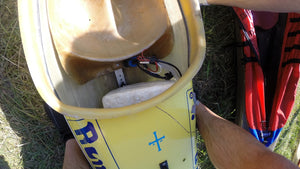
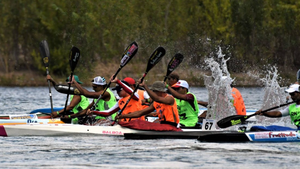
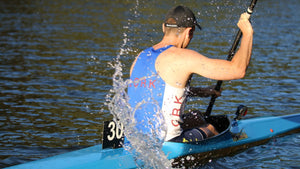
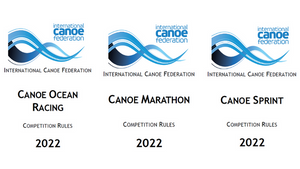
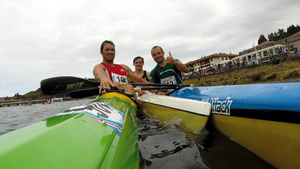
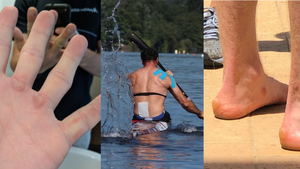
Comments 0